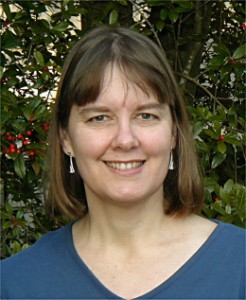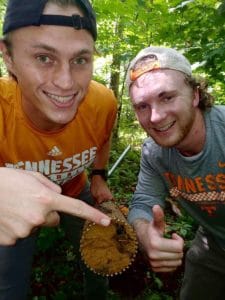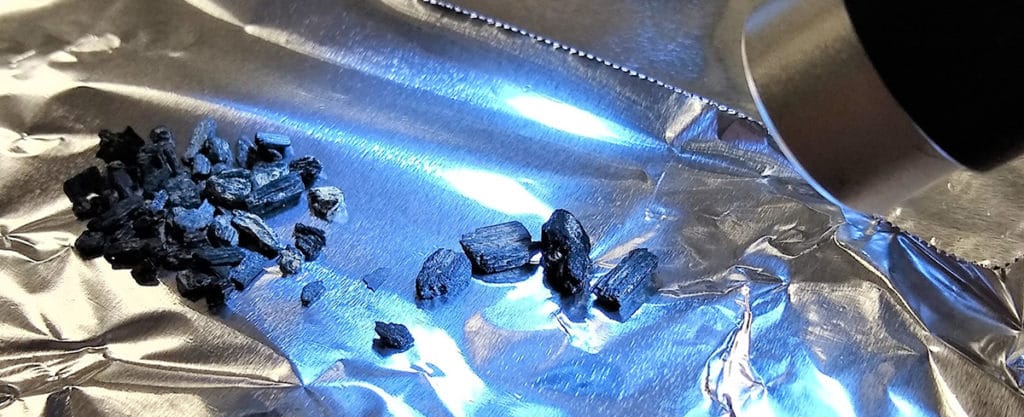 Sally Horn, professor of geography, is working with charcoal in soils in the Great Smoky Mountains National Park to chart a history of fires in the area. This research could lead to a broader understanding of the long-term relationships between fire, climate, and human activity.
Sally Horn, professor of geography, is working with charcoal in soils in the Great Smoky Mountains National Park to chart a history of fires in the area. This research could lead to a broader understanding of the long-term relationships between fire, climate, and human activity.
Horn began her academic studies as a journalism student but soon found geography to be a better fit, preferring hiking and working outdoors to digging up political scandals as was the obsession at the time in news rooms and journalism classes alike. Despite this shift, her life’s work continues to uncover stories, but from a different perspective – revealing the narrative of a landscape with research, unlocking its history one charcoal fragment at a time.
The presence of charcoal in soil indicates a past fire. Horn’s research digs into that past by analyzing pieces of charcoal for information about plant life in an area where and when the fire occurred.
“From these small fragments of charcoal, we can identify what kind of wood was burned in the fire. This tells us what kinds of trees and other plants were growing in the area at that time,” said Horn.
Her team uses wood morphology, a microscopic analysis of the cellular structure of wood, to identify the charcoal pieces and determine what kinds of trees burned to make them. Using radiocarbon dating, she can then situate the fire in the historical timeline, providing a backwards glance at the terrain and vegetation of a forest’s past.
“These pieces of charcoal can be preserved for thousands of years, so when you look at charcoal that’s 7,000 years old, we are seeing the remains of trees that burned when the climate was likely different. We might actually be finding evidence of changes in the ranges of plants in the past,” said Horn.
Horn has spent a great deal of time working in the neotropics, travelling with student researchers to Costa Rica and the Amazon to collect and analyze samples. Eventually she found herself conducting research in the Great Smoky Mountains National Park.
“There have always been people from the university working in the park, back to the earliest botany classes,” said Horn. “I started working in the park as a way to involve students in local work. This is our state, our home.”
In keeping with UT’s spirit of collaboration Horn’s project is a joint effort with a former graduate student, Chris Underwood, who is now a faculty member at the University of Wisconsin in Platteville. Unfortunately, due to COVID related travel complications, he and his students were unable to get to Tennessee for field sampling. Horn’s cadre of local graduate students stepped in to fill the unexpected gap, working around teaching duties, weather constraints, and scheduling conflicts to collect soil cores from the park. Grad students also worked with undergraduate students to separate the charcoal from the soil by sieving.
 “It really was the graduate students, and the kindness and dedication on their part that kept this project going,” said Horn. She and Underwood are now analyzing patterns in the ages and identifications of the charcoal fragments. She is also planning new work on charcoal and other indicators of past history preserved in sediments in Great Smoky Mountains National Park and in other areas of Tennessee.
“It really was the graduate students, and the kindness and dedication on their part that kept this project going,” said Horn. She and Underwood are now analyzing patterns in the ages and identifications of the charcoal fragments. She is also planning new work on charcoal and other indicators of past history preserved in sediments in Great Smoky Mountains National Park and in other areas of Tennessee.
Horn’s research transforms the remnants of natural disasters into snapshots of the past. In doing so, she and her team seek to uncover a deeper knowledge of the changing landscape of the Great Smoky Mountains, some of the oldest mountains in the world, from a time prior to written history.
“Looking at charcoal in the soil is a way to go back in time to learn about vegetation, and because it’s charcoal we’re actually going back in time on fires as well,” said Horn. “This work can tell us so much about the region’s history that can inform future forest management practices, our understandings of the long-term development of forest stands, and how we interact with the landscape in general.”
